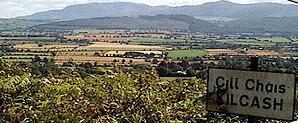Readings for the Oct. 18
Feast of St. Luke
A fellow Xangan is undergoing a spiritual crisis. Well-meaning friends are urging upon her all sorts of advice. The following is my best effort at religious counsel, meant more for the friends than for the woman in crisis.
Part I... Wallace Stevens
From Brewer's Dictionary of Phrase and Fable:
Ox Emblematic of St. Luke. It is one of the four figures which made up Ezekiel's cherub (i. 10). The ox is the emblem of the priesthood....
The dumb ox. St. Thomas Aquinas; so named by his fellow students at Cologne, on account of his dulness and taciturnity. (1224-1274.)
Albertus said, “We call him the dumb ox, but he will give one day such a bellow as shall be heard from one end of the world to the other.” (Alban Butler.)
From Wallace Stevens, "The Latest Freed Man":
It was how the sun came shining into his room:
To be without a description of to be,
For a moment on rising, at the edge of the bed, to be,
To have the ant of the self changed to an ox
With its organic boomings, to be changed
From a doctor into an ox, before standing up,
To know that the change and that the ox-like struggle
Come from the strength that is the strength of the sun,
Whether it comes directly or from the sun.
It was how he was free. It was how his freedom came.
It was being without description, being an ox.
Part II... The Rosy Cross
Readings:
- Brautigan, Richard, The Hawkline Monster, Simon and Schuster, 1974...
Just for the pleasure of reading it... A compelling work of fiction on spiritual matters that includes a conversion to Rosicrucianism in its concluding chapter.
- Browning, Vivienne (Betty Coley, ed).
My Browning Family Album. With a Foreword by Ben Travers, and a Poem by Jack Lindsay Springwood, London, 1979...
The Rosicrucian tradition in Australia (highly relevant background reading for the 1994 film "Sirens"). Includes a mention of Aleister Crowley, dark mage, who also figures (prominently) in....
- Wilson, Robert Anton, Masks of the Illuminati, Pocket Books, April 1981...
James Joyce and Albert Einstein join in a metaphysical investigation.
"He recited from the anonymous Muses Threnody of 1648:
For we be brethren of the Rosy Cross
We have the Mason Word and second sight
Things for to come we can see aright."
Part III... Stevens Again
A major critical work on Wallace Stevens that is not unrelated to the above three works on the Rosicrucian tradition:
Leonora Woodman, Stanza My Stone: Wallace Stevens and the Hermetic Tradition, West Lafayette, Indiana: Purdue University Press, 1983
From the Department of English, Purdue University:
Leonora Woodman came to Purdue in 1976. In 1979, she became Director of Composition, a position she held until 1986.... At the time of her death in 1991, she was in the midst of an important work on modernist poetry, Literary Modernism and the Fourth Dimension: The Visionary Poetics of D.H. Lawrence, H.D., and Hart Crane.
For more on Gnostic Christianity, see
- Elaine Pagels, The Gnostic Gospels (Random House, 1979), and
- Harold Bloom, Omens of Millenium: The Gnosis of Angels, Dreams, and Resurrection (Riverhead Books, 1996).








Recent Comments